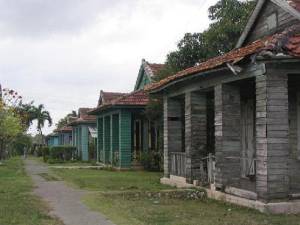Hershey, Cuba (The last model town)
By Dmitri Prieto

Amarilys Ribot’s book Hershey has several virtues. Written in an unconventional style for a research study -the book at times reads more like a poem or a story than a scientific text-, the essay tells the story of the multifaceted social vitality of the town under the patronage of Mr. Hershey.
For example, the town enjoyed such facilities as the Hershey Sport Club and the Hershey School. We also learn about the technological processes involved in running the sugar mil, the revolutionary Cuban government’s role in administering the mill and the history of the famous electric train.
Mr. Hershey had a surprising vocation for local development and set up a network of public services around the sugar mill. Maybe this is why some of the older residents still fondly remember Milton S. Hershey.
One detail: By the time the Cuban Revolution came into power in 1959, the Hershey Chocolate Corp. had already sold the mill to Cuban industrialist Julio Lobo, and as such the business was expropriated from a Cuban capitalist and not the US company.
A look at the history of the town of Hershey gives rise to an interesting debate regarding the fate of modernity in Cuban and the world, and the historic relations shared between Cuba and the United States. It also reveals some of the complexity surrounding an emerging culture in the midst of two different social classes -bourgeoisie and working-, and the resulting networks that cross between the different classes, races and nationalities.
How did these networks function? What nourished the sentiments that ran through them? I am surprised that older people in Santa Cruz never say anything negative about the old American capitalist, founder of the town that will always carry his name.
At the same time I feel how dramatic it must have been to live one’s whole life at the rhythm of the industrial call for production quotas; at the whim of the factory’s siren. The methodic order in which the US-styled houses built by Hershey are laid out strongly transmit a sense of rationality. But modern rationality is contradictory; comfort also gives rise to rebelliousness, inequalities and much more.
How can we make the feelings that cross over the social class lines compatible with the traditionally held vision of the classist society of pre-revolutionary Cuba? What will happen to Hershey as its sugar producing tradition slips further and further into the past? I will leave these questions to future historians…and to the residents of the “last model town.”






After reading Deborah Cadbury’s brief account in her book “The Chocolate Wars”
Milton Hershey felt obliged to improve the workers lives and built the homes and facilities to do just that. He may have been a capitalist but his heart was in the right place.